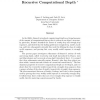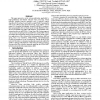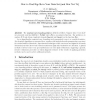54 search results - page 8 / 11 » re 1997 |
ICALP
1997
Springer
13 years 11 months ago
1997
Springer
In the 1980's, Bennett introduced computational depth as a formal measure of the amount of computational history that is evident in an object's structure. In particular,...
ARVLSI
1999
IEEE
13 years 11 months ago
1999
IEEE
The ability of animals to select a limited region of sensory space for scrutiny is an important factor in dealing with cluttered or complex sensory environments. Such an attention...
FPGA
1997
ACM
13 years 11 months ago
1997
ACM
This paper presents a novel system architecture applicable to high-performance and flexible transport data processing which includes complex protocol operation and a network contr...
ICS
1997
Tsinghua U.
13 years 11 months ago
1997
Tsinghua U.
Program slicing is an analysis that answers questions such as \Which statements might a ect the computation of variable v at statement s?" or \Which statements depend on the ...
IDA
1997
Springer
13 years 11 months ago
1997
Springer
The empirical curve bounding problem is de ned as follows. Suppose data vectors X Y are presented such that E(Y i]) = f(X i]) where f(x) is an unknown function. The problem is to a...



